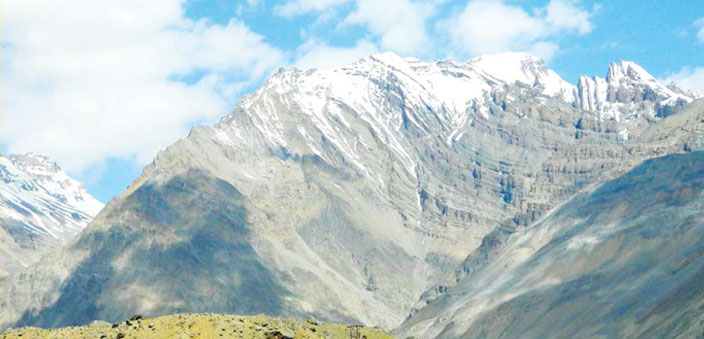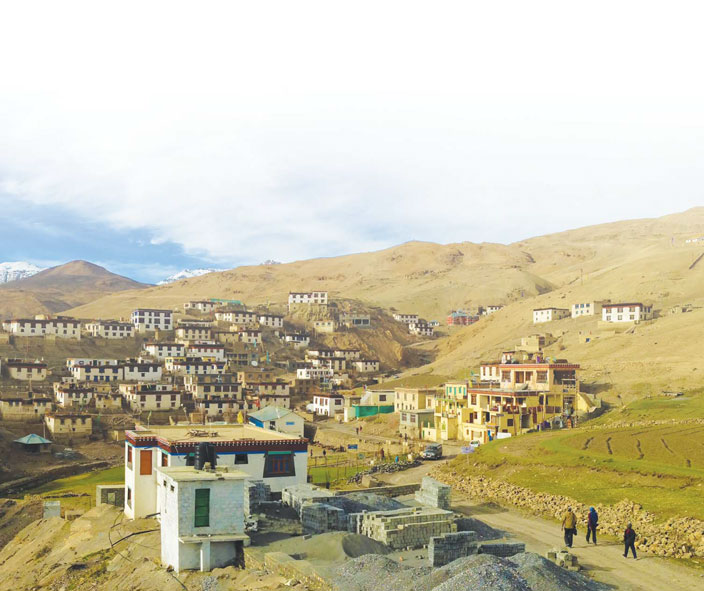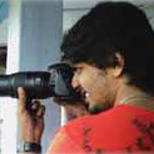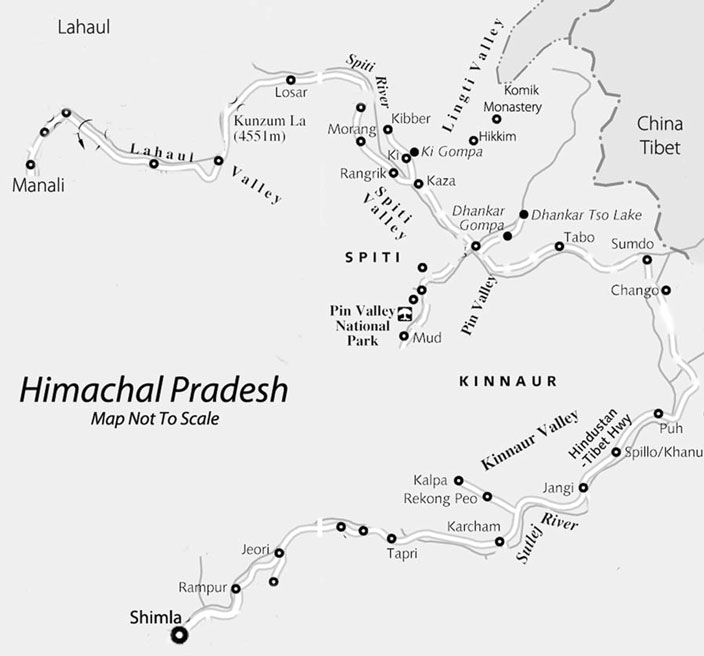
What country is that?”, “Is it near Haiti?”; are amongst the more bizarre of the responses I have had thrown at me when I have recounted my trip to Spiti Valley. Raised eyebrows, bewildered expressions and a lost look on the faces are what I have deduced to be normal reactions. Quite ironically, those were the same expressions I had on my face when I visited the extravagantly beautiful valley of Spiti. The only difference – mine stemmed from a place of astonished, unbelieving awe.
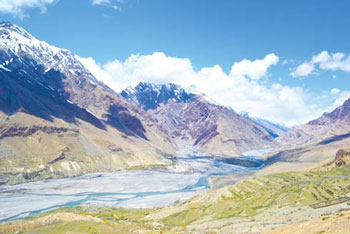
Nestled in the north-eastern corner of the state of Himachal Pradesh, in the district of Lahaul and Spiti; Spiti Valley is very much in India and nowhere close to Haiti. It borders Tibet in the East and Ladakh (Jammu & Kashmir) in the North. To the West and South are districts of Himachal Pradesh – Chamba and Kullu in the West and Kinnaur to the South. In essence, the valley of Spiti is a continuation of the Tibetan Plateau and similar in topography, landscape and culture to the Ladakh region of India and the Tibet Autonomous Region. Historically the area has been a border area and the name in Tibetan means exactly that – ‘the middle land’ between India and Tibet. Another theory is that the original word is Piti which means ‘the middle land’ and is also the name of the river that flows through the region; making Spiti (sa + piti) the country of the Piti River.
The region in early times was ruled by the Sen kings. Its fortunes declined during the reign of Chet Sen in the 7th century and it was annexed by the kingdom of Ladakh. In the 10th century, the kingdom was given to one of the three sons of the king of Ladakh and since then, the fate of the region has been inextricably linked with Ladakh. During the reign of the Ladakhis, local rulers called Nono’s – a hereditary post – were in charge of day to day administration. In 1846, the region of Spiti was brought under the control of the East India Company and that joined its lot with the rest of India. After independence Lahaul and Spiti remained separate districts till 1960 at which point they were combined with Keylong in Lahaul being made the present administrative centre.
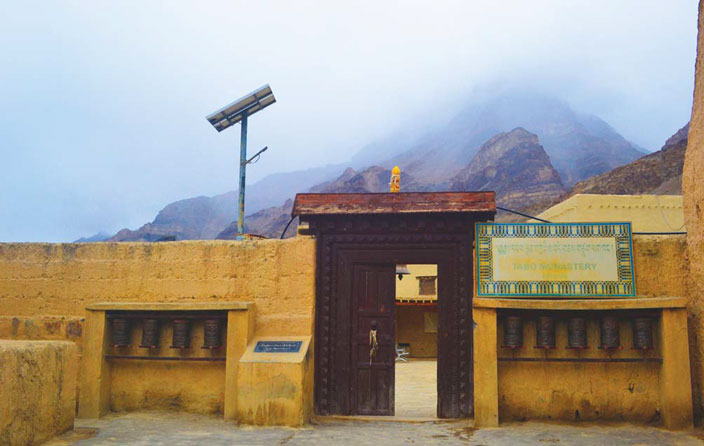
It is quite hard to fathom the moods of the planet when mere kilometres from the dense forests of Himachal, the earth turns arid without warning or prelude. Much in the same manner like the transformation from the bountiful land of Srinagar to the desert of Ladakh after crossing the Zoji-La Pass in Kashmir. Perhaps it is the relatively easy accessibility of Ladakh through Srinagar and the airport at Leh that has contributed to the fog of unawareness that clouds the rain shadow region of Spiti. There can be no other logical reason as to why the place is not popular amongst tourists. That and the fact that getting to the valley of Spiti offers just as much excitement and adventure as the valley itself!
The road trip – unexpected acquaintances
There are two routes that one can take to get to Spiti. One is through Manali and traverses through Lahaul before one approaches Spiti through the Kunzum Pass (15,059 ft.). This route is cut off during winter as snowfall and icing conditions make it impossible to traverse the high altitude pass. The southern approach via Kinnaur from Shimla is an all season route of 412 kms. from Shimla to the Spiti sub-divisional headquarters of Kaza – twice as long as the 201 km. route from Manali.
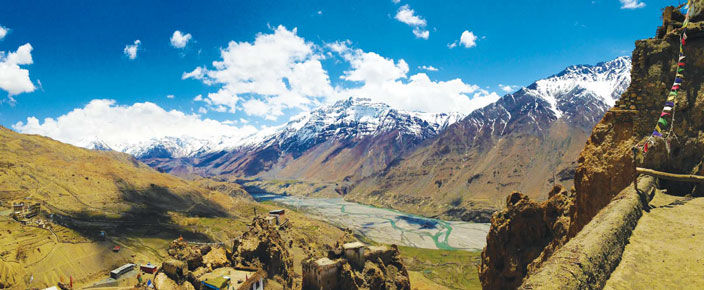
Travelling with the ever youthful brigade of the Wilson College Nature Club (WCNC) with its eccentric professor at their helm, it was effortlessly predictable that while the expected, planned events may or may not happen, the unexpected surely will. With Kunzum scheduled to be negotiable only towards the middle of June, my travel plans in the month of May left only one option for us – the route through Kinnaur. One would expect that an all season road would mean a long and uneventful drive to Spiti and an unhindered following of an exotic itinerary. But wait! Did I not just say that the unexpected is sure to happen?
Our journey began from Kalka station with the first pitstop scheduled at Rampur – a small city roughly 130 kms from Shimla. Several small delays, primarily the traffic nightmare within Shimla made an estimated dinner time arrival in Rampur more like a middle of the night arrival. However, the long rest on the train from Mumbai to Kalka made sure that the spirits were high and after a quick meal and couple of hours of sleep, we were ready to leave at the crack of dawn towards our destination of Tabo in Spiti. Little did we know that the imp whose job it is to create itinerary disasters was busy at work and barely three hours away, we were made to halt at a small wayside town of Tapri. The cause for what seemed like a small delay was shooting stones on the road just outside the town. Now landslides and delays because of them are common in the Himalayas and one just expects the debris to be cleared and life and traffic moves on.
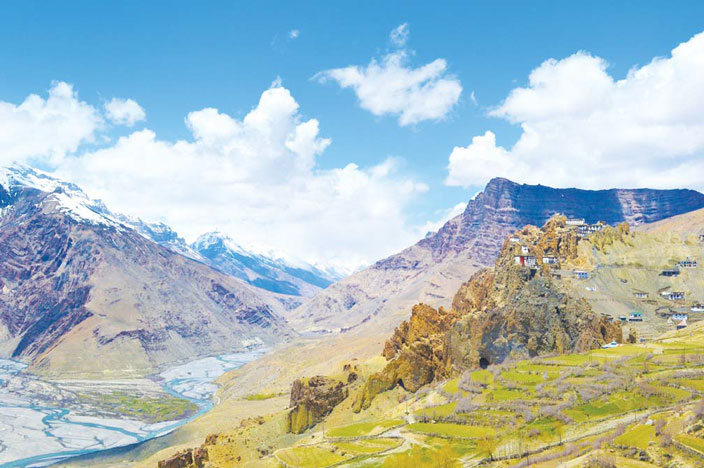
Assuming this, we decided to make the best of the delay and gobble up some food and tea. In conversation we realised that people had been stuck at Tapri for as much as three days as the landslide wouldn’t stop and the recent rains had made the situation worse. This was confirmed by some army jawans who were themselves camping in their jeep for a couple of nights. When an army vehicle is not granted permission to proceed on a road, it spells serious trouble and this sobered us a little. Still there was hope that by evening the road would clear and we would be allowed to proceed.
I am always fascinated by such delays. While they are definitely inconvenient, they provide the perfect opportunity to explore a place you would otherwise never have met. And for simultaneous entertainment are the eclectic bunch of people stuck together and their views and experienced analysis of how long it would take for the road to open and the various processes that would need to be executed till that opportune moment. Just like the expert views everyone has about how the Indian team should be playing and the correct team composition and batting order, every driver, shopkeeper and traveller has their conviction in these matters. The time range for the now infamous Tapri shooting stones to subside ranged from 20 minutes to two days depending on who you asked. Some even insinuated that the local authorities would let people pass with some money changing hands.
The best solution in these matters, in my opinion, is to make the most of the time at the place and if there is an option of retracing your steps – set a deadline of time you are prepared to wait and then move, irrespective of what anyone says. Luckily there was an alternate route, which though not advised for large vehicles was prepped up by the authorities to allow a little risky, but possible detour. And this little road above Tapri, informed to us by some local residents – in the same manner as the little path around ‘The Hot Gates’ of Thermopylae – allowed us passage towards Spiti. Sumdo, at a distance of 74 kms from Kaza is the point of entry into Spiti. Travelling alongside the Spiti River, our first halt was the grand old monastery of Tabo.
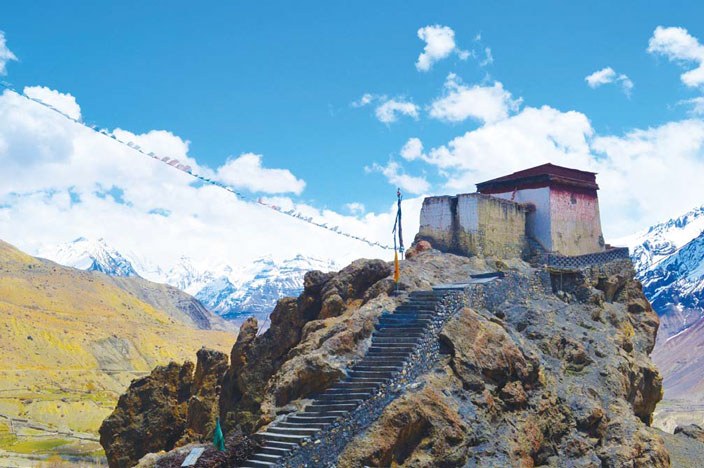
Where monks dwell
Like people, the influence of change too finds it difficult to make an early entry in places as remote as Spiti and old tradition, cultures and ways of life continue or co-exist with change more peacefully than in other parts where change conquers all with little respect to time. Spiti, though now connected by road and modern amenities remains one of the sanctum sanctorum of the Lamaist Buddhist monasteries. The oldest of these monasteries is the monastery of Tabo which holds the distinction of being the oldest continuously functioning Buddhist monument in India. The Tabo monastery holds an extraordinary wealth of documentation detailing the history and culture of the region through paintings, sculpture, inscription and extensive wall texts.
Founded in 966 CE at an altitude of 10,004 feet above sea level, the monastery and the village of the same name are over a thousand years old. Tradition attributes the famous Buddhist teacher and translator Rinchen Zangpo as the founder of this monastic complex. The complex itself holds nine temples 23 chortens or stupas, a monk’s chamber and an extension that houses a non chamber. In the cliff faces that surround the monastic complex are several caves, which were once used for meditation. The locals tell that faint traces of paintings are still visible in some of them.
While the monastery has plain mud walls on the outside and the complex is thoroughly unimpressive to look at, the art inside the monastery, however, is in fantastic condition and its close resemblance to the paintings found at the world heritage site of Ajanta caves in Maharashtra has had the monastery dubbed as the Ajanta of the Himalayas. Dedicated to the entire Buddhist pantheon, the high quality of the stucco images that adorn its walls and the richness of its paintings have earned lavish praise from the Dalai Lama himself, who has expressed his desire to retire to Tabo.
The Tabo village provides for various alternatives for accommodation from home stay to what would be luxury in these parts. We were fortunate enough to get bookings in the monastery guest house, living in which is an altogether sacred experience in itself. Not high on creature comforts but good balm for the soul. It was also at Tabo that we experienced the problem that plagues Spiti – the shortage of electric power supply. Despite the many hydro-electric projects on the road to Tabo, it was surprising to discover that erratic supply had been such a problem that the day after we reached, a strike had been declared to protest the problem. Luckily for us, a nearby hotel owner risked the penalty on Rs. 2000 and prepared breakfast for us, served discreetly in the dining chambers of the monastery guest house.
From Tabo, our next stop was the fort monastery of Dhankar. Situated between Tabo and Kaza, Dhankar was once the capital of the Spiti valley kingdom. Situated at an altitude of 12,774 feet, the monastery itself is built on an out spurt of a 100 foot tall mount making for a remarkable setting. The name itself originates from dhang or dang meaning cliff and khar which means fort, literally meaning the fort on a cliff. As the monastery held political power with the rulers dispensing justice, it was also a fort built for defensive purposes. It is modelled after many central Tibetan buildings which served this dual purpose. Experts have concluded that the features in the buildings show evidence of occupation since at least the 12th century.
At that high altitude, the small climb to the monastery and the fort seems like an effort for us plains dwellers. After all the wheezing and panting to get to the pinnacle the astounding panorama which includes the confluence of the Spiti and Pin rivers absolutely makes the effort worthwhile and the sight a mental image that will not be forgotten in a hurry.
A few kilometres from the monastery lies the high altitude lake of the same name – Dhankar lake. A fresh water lake in the middle of arid desert is a wonder in itself and those who have made that trek swear by the beauty of the lake affirming that no picture could ever do justice to the vista that the naked eye absorbs. Though the trek was on the itinerary, the day spent at Tapri made it the first and thankfully the only casualty to the planning. On an honest note to myself, I was pretty relieved that we couldn’t make it as I don’t know whether I would have physically been up to trekking the five-odd kilometres to the lake at that high altitude when that little jaunt to the monastery had quite literally taken the wind out of my sails. It remains on my list as a definite ‘to-do’ for the next time I visit there.
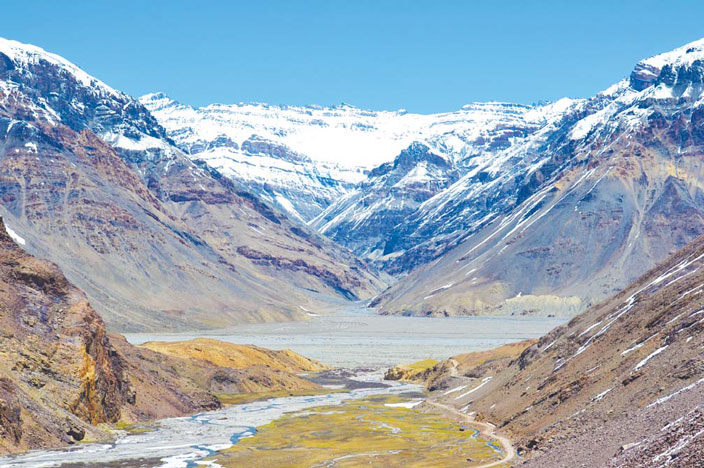
The wild valley of Pin
Spreading south from the Dhankar monastery following the Pin River which originates in the Pin Parvati glaciers, is the natural interface that separates the once separate districts of Lahaul and Spiti. Known as the Pin valley after the river, it is a region of hills, cliffs and mountainous crevices with grassy lower slopes. Despite its semi-frozen rivers and sub-zero temperatures, the valley which was once submerged under the Tethys Sea, is home to several rare species and other interesting wildlife.
Best known for the Siberian Ibex and the Snow Leopard, the Pin Valley National Park was formed in 1987 to protect the unique Himalayan flora and fauna. The blue sheep, Tibetan wolf, Himalayan fox, pika – the mouse hare can also be encountered here. Though the flora is limited with patches of alpine trees and Himalayan cedar the rare Himalayan Snowcock, chukar, red-billed and yellow-billed Choughs, Kestrel, the snow partridge and snow finch flourish in the national park.
Despite the tiredness of the early hour or rising and the strain of the Dhankar walk, the very entry into Pin valley had a strange engaging kind of excitement which was highlighted by the spotting of a fox trotting alongside the bus as we made our way to Mudh village – the last village of Pin Valley, situated at an altitude of over 12,500 feet.
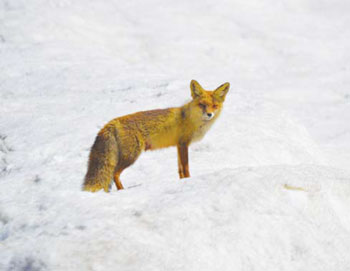
Our arrival at the village was its own little excitement for the villagers who are not accustomed to Indian visitors as most tourists to the village are foreigner’s intent on trekking to the Pin Parvati and Bhabha Pass trails which begin at Mudh. Our 35 seater bus was also a star as it was the only private bus to have entered the village since a wedding over a decade ago. As we enjoyed these interesting trivia we were being offered, it struck home exactly how remote this area was and how far removed from modern civilisation the people of the village were.
A friendly, humble lot, they went out of their way to ensure that we were comfortable and our fire-wood cooked meals remained hot. With no building having 10 rooms to let out, the group had to be split in three hotels with the locals promising a bigger hotel for the next time we visit!
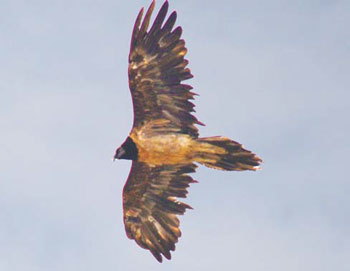
Surrounded by frosty fields and a river still half frozen, the setting of the village is ethereal. Recent snowfall and an avalanche that blocked the small patch of road that led outside the village to the hills added to this setting. The wildlife in the area must be rich, given we sighted three more foxes in the space of an hour and the villages reckoning them the way we would to dogs in the city. The blue sheep and Ibex, we were told, were frequent visitors and nearly every person in the village had at some point in their lives spotted a snow leopard! Given that on the way back, we did spot the Ibex, makes me completely believe their claims. My appointment with the snow leopard, however, seems to be indefinitely delayed. Yet, in hope I live and travel.
In the heart of Spiti
Lest we forget that we are at high altitudes in the Himalayas, there are enough boards and claims once you enter Kaza to make you realise that you are at amongst the highest inhabited places in the world and in that zone where civilisation and nature are at constant loggerheads, challenging the other’s presence. Sitting comfortably in a vehicle – something we take for granted – it scarcely crosses our mind that it requires fuel to move them. And if getting myself to 14,000 plus feet was so, difficult, just how difficult must it be to maintain a constant supply of petrol and diesel! But it is done quite spectacularly at the world’s highest retail outlet in Kaza at 12,270 feet!
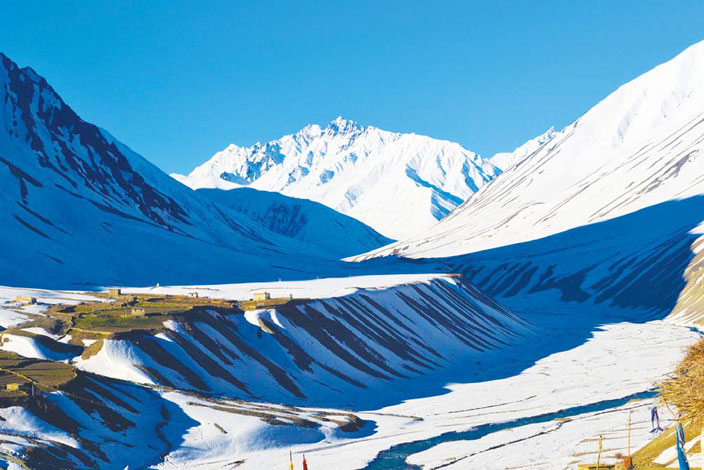
Kaza is itself divided in two distinct sections – old and new, known as Kaza Khas and Kaza Soma respectively. Overlooked by high mountains on all sides within which are situated many other ‘world’s highest’ claims, Kaza is conveniently placed in the centre of Spiti valley and with the good connectivity and other facilities available to the headquarters of a region, it is the ideal starting and refilling point for any expedition in the valley. Just around Kaza, there are enough day trips to keep one busy for at least a couple of days. And each one has something to brag about on social media.
Just seven kilometers from Kaza is the largest monastery in Spiti valley – the Key monastery (also called Ki, Kee or Kye). Built in the 11th century, it has numerous ancient Buddhist scrolls and paintings. Primarily a training school for lamas, its history is as spectacular as its precarious setting overlooking the valley and the Spiti River. It is believed that at first the monastery was located in the nearby village on Rangrik where it was destroyed by the Mongols in the 14th century. Rebuilt at the current location, it was again attacked in the 17th century by the Mongols. In 1820, it was sacked during the wars between Kullu and Ladakh. In the 1840s it was ravaged by fire and in 1841 it was attacked first by Ghulam Khan and Rahim Khan of the Dogra army and then later in the same year by the Sikh army. More recently in 1975, it was severely damaged by an earthquake and then restored with the help of the Archaeological Survey of India and State Public Works department.

This repeated destruction has caused a quite haphazard growth with temples being subsequently built on top of one another like boxes, giving it a unique appearance of a fort built in the Pasada style of architecture with more than one storey and often serving the role of a fort. The monastery has several low rooms, narrow corridors and not so well lit passages. The structure is itself a labyrinth with scattered prayer rooms accessible through small doors. Along with the wealth of Buddhist literature and art work, the monastery also houses many weapons and some unique wind instruments which are still brought out in the summers. It is best to explore the monastery with a monk who can open the many locked rooms in the monastery and talk one through the use and significance of the monastery and its many stories and the various Tibetan inscriptions on its walls. In 2000, Key celebrated its millennium year in the presence of the Dalai Lama.
The road from Key monastery further leads to the village of Kibber, pegged as the second highest motorable village in the world at 14,200 feet. There are several such high altitude inhabited villages in the Spiti region, only a few of which have access by road. Kibber, built on the summit of a limestone rock is unique for being a village with houses built of stone, unlike the mud and adobe bricks houses more commonly found in Spiti. The village is home to a monastery and the Kibber Wildlife Sanctuary established in 1992. The sanctuary is well known for having some endangered medicinal plants used in traditional Tibetan medicine.
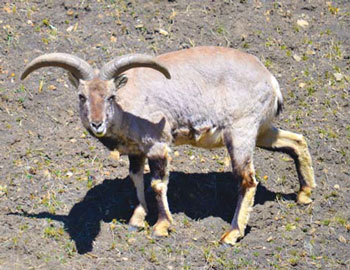
With Kibber being the second highest motorable village, it’s natural to inquire about the highest motorable village, which not surprisingly is only a couple of hours drive from Kaza. The village of Hikkim across the river holds the distinction for being the highest polling booth in the world at 14,567 feet above sea level. It is also home to the world’s highest post office; feats for which it finds mention in the Limca book of records.
A little way from Hikkim – a little higher up, needless to say – is the world‘s highest motorable village of Komik. It is also one of the highest altitude village in the Himalayas at over 15,000 feet. Somehow, it’s quite fitting that the world’s highest monastery is right above this village. Known as Komik monastery, it dates to the 14th century and is built like a fortified castle with massive slanted mud walls and battlements with vertical red ochre and white vertical stripes.
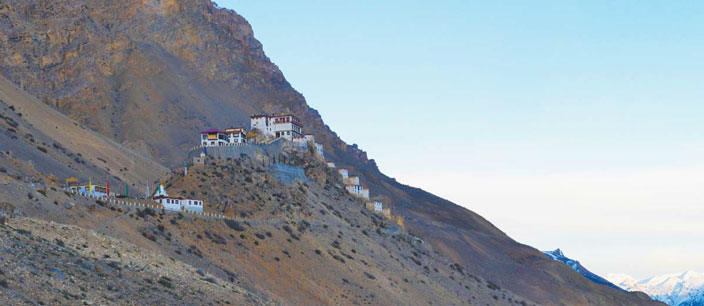
There is no paucity of legends and mythological stories in Spiti with almost every mountain, building and stream having a local legend associated with it steeped in a heady mix of history and fantasy. The most intriguing of these is the one associated with the Komik monastery. As per local lore, there was once a severe drought in the area and so the priests of Komik decided to move the monastery to the comparatively lower altitude of Hikkim. While the entire monastery was shifted to a newly built structure, the main statue of Mahakal – the protector of dharma refused to budge from its foundation in the ground of Komik. After many chipping and lifting efforts by the monks, they finally gave up and a monk remained behind to pray and carry out the rituals for Mahakal. It continued this way till the 1975 earthquake, in which the new monastery at Hikkim was completely destroyed but there was no damage to this statue, which firmly held its ground. Taking this as a sign, the monastery was moved back to the higher ground of Komik, where it still stands. Interestingly, the temple dedicated to Mahakal does not allow women inside with the feeble excuse that the deity is so powerful and deadly that women may not be able to withstand the force of that personality.

On the return journey to Kaza, the guide made a pit stop at the village of Langza near which is an area where fossils of marine life from the time when the entire area was under the Tethys Sea can be found amongst the rocks. A good 30 minute search revealed quite a fair amount of rocks, some with distinct imprints of marine life in them. Hundreds of others still lie there for the discerning tourist with a curious eye. While in search of fossils, we also came across a large herd of blue sheep which caused great excitement in us, much to the amusement of the locals for whom they were as common as cattle.
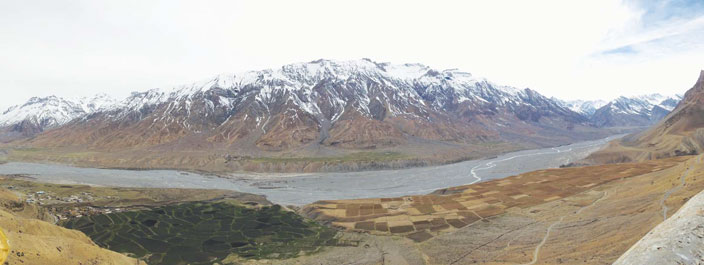
Atithi Devo Bhava – A guest is God incarnate
Having traversed the length of the Spiti valley, it was time to retrace our steps back to Kalka, from where it all began. It had been a while since the unexpected caught up with us and as lower altitudes returned, Murphy’s law about whatever can go wrong, will go wrong; reared its mischievous head once again. The ‘expected’ delay at Tapri never happened with the shooting stones taking a break but a little way ahead, a diesel tanker quarter full with fuel had overturned right in the middle of a narrow single lane track, making passing impossible. Again the hundred theories and predictions of when it would be cleared were doing the rounds as the tanker was slowly being emptied by everyone taking turns to get their share of free diesel, despite the local police pleading with people to stay away from the leaking tanker as it was dangerous.
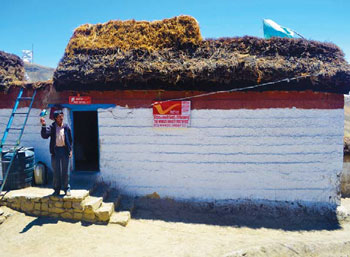
But I digress. The real point of writing this is completely different. The real story here – the chance encounters that such situations effect is my heart warming take away from this situation. With the prospect of another cold night on the road, we went looking for shelter. On a whim, a couple of us walked up to a nice house on the hill and knocked on their door. A lady opened the door and we explained our predicament requesting if at least the girls in the group could stay with them for the night. Without any hesitation she agreed and went about making preparations for us to be comfortable. This, for a bunch of ragamuffin strangers who just walked up and announced themselves. This, without consulting with anyone in the house and then going about arranging beds and blankets around the three spare rooms and accommodating their entire family into one room so that we could be comfortable.
The next morning, we had an opportunity to meet the entire family and each one was humble, welcoming and helpful. We attempted to give a little money for their troubles which was swiftly and firmly turned away drawing on traditional principles of hospitality which are an endangered commodity in our modern, suspicious world. Our heartfelt thanks to them when orally expressed brought tears to their eyes and a bond was formed – an inexplicable lifelong relationship where we may never meet again but we will remember each other for many moons over countless retellings of the story of that fateful night. We will recount our blessings and they will laugh at our peculiarities and in our memories keep each other alive.
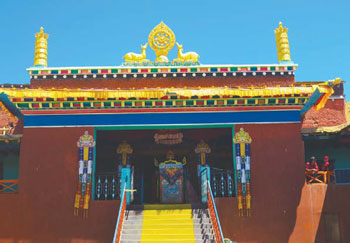
This is my biggest gift from Spiti – that stoic, hard hearted, primordial looking world, in one swift stroke, brought me back into the circle of humanity. For as long as we live, the memory of this generous act, I hope, will inspire all of us who experienced this pure gesture to look beyond ourselves and extend a helping hand. Travel makes you hardy, they say. Well, it softened me in the process and I am glad for it.

Au revoir, not goodbye
It’s a surreal world in Spiti. Every frame is an element of surprise, unexpected juxtapositions and non sequitur. The unending emptiness, a vast canvas on which dreams and reality lay bare the innermost recesses of your soul in a manner which makes it impossible to separate the two. In that wild, wonderful world, I would not recommend you expend effort to disjoin them. Let them fester and follow you around like an imaginary bird perched on your shoulder, gently whispering in your ears fables of the beauty in desolateness that the logical mind is not equipped to appreciate. Allow this bubble of ludicrous interpretations all the impetuousness it is capable of. And I promise you, in those myriad shades of grey, will emerge in vivid colours and astonishing detail a view of everything that life can be – that life should be…

